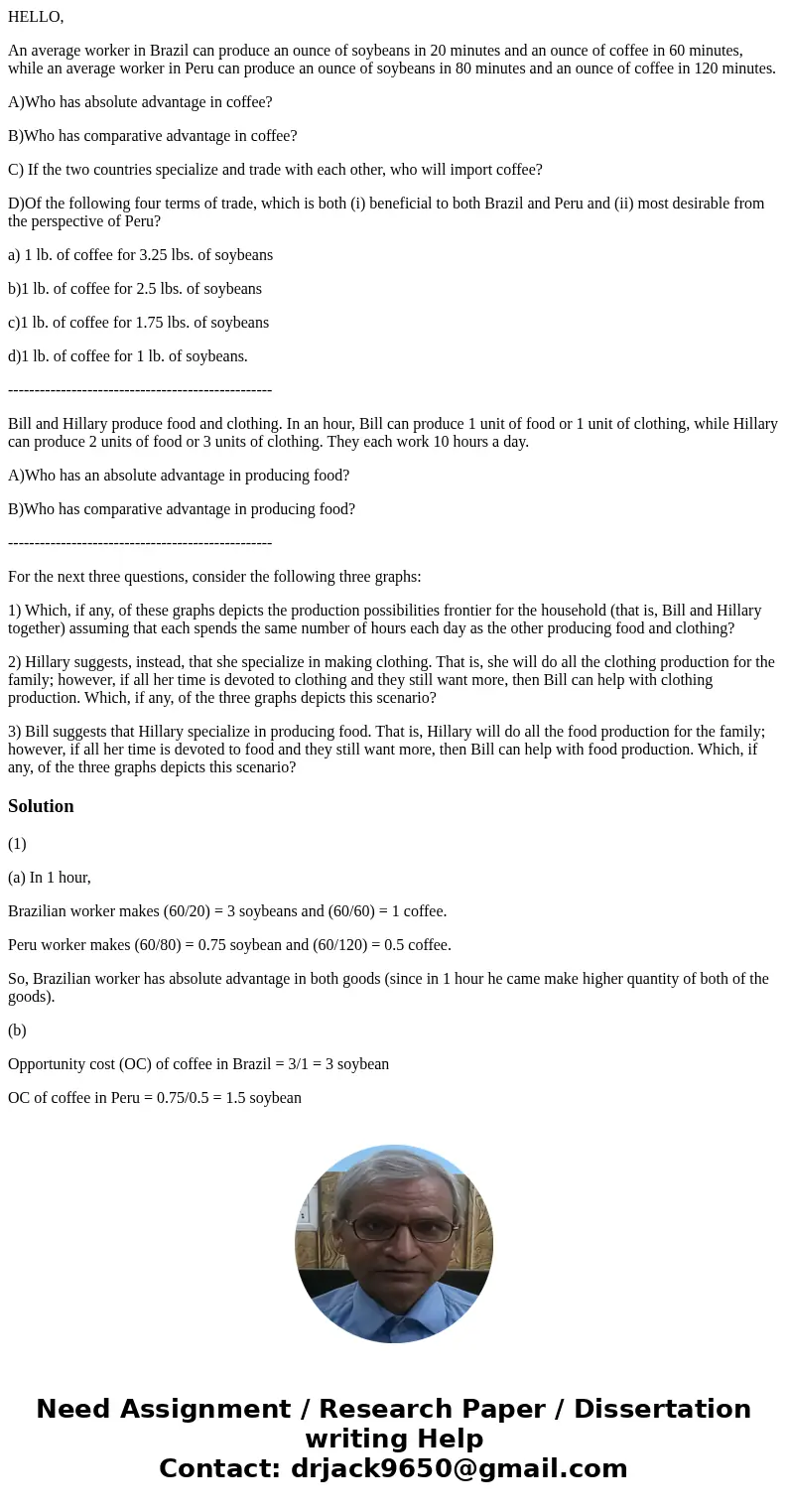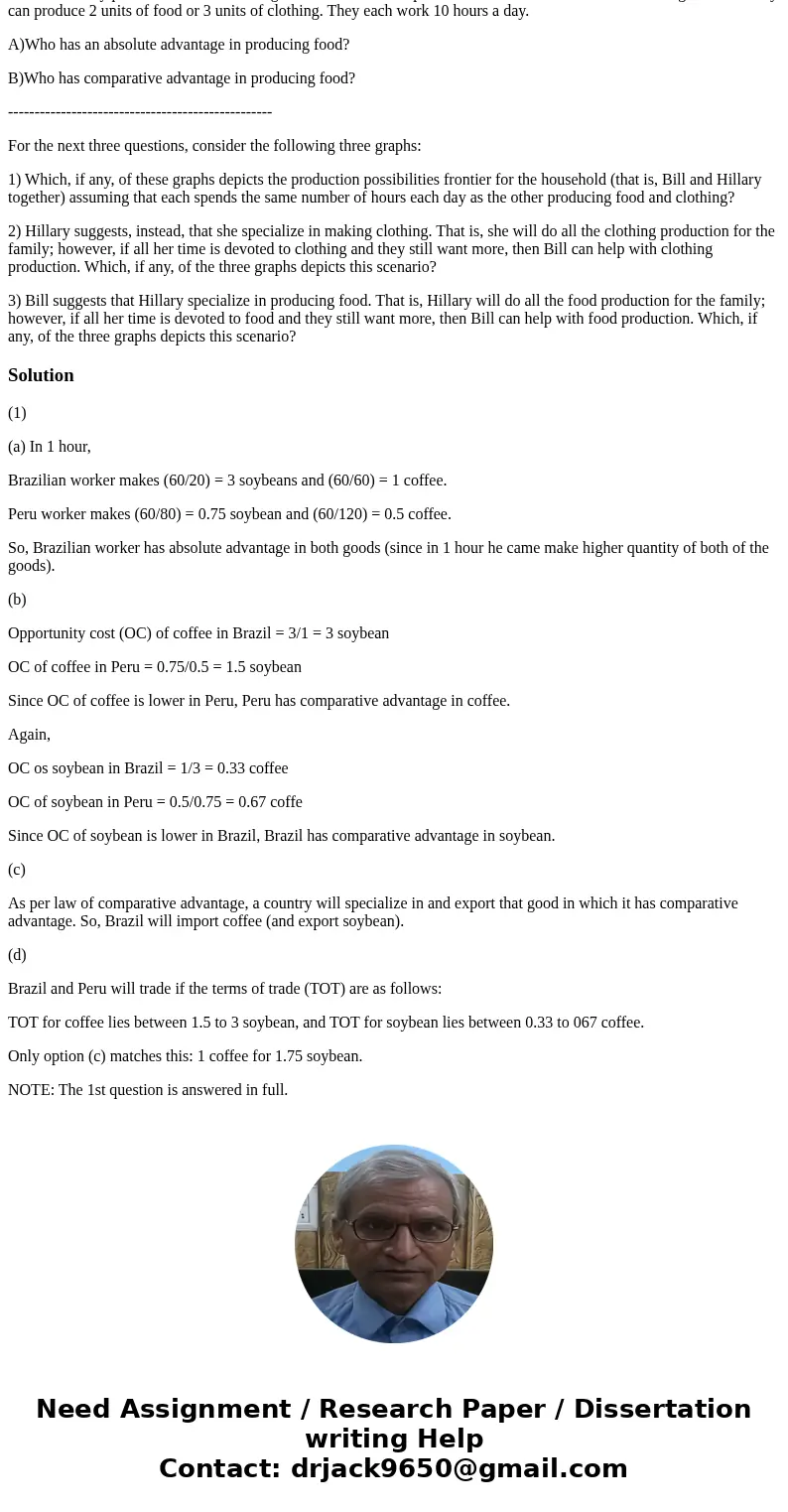HELLO An average worker in Brazil can produce an ounce of so
HELLO,
An average worker in Brazil can produce an ounce of soybeans in 20 minutes and an ounce of coffee in 60 minutes, while an average worker in Peru can produce an ounce of soybeans in 80 minutes and an ounce of coffee in 120 minutes.
A)Who has absolute advantage in coffee?
B)Who has comparative advantage in coffee?
C) If the two countries specialize and trade with each other, who will import coffee?
D)Of the following four terms of trade, which is both (i) beneficial to both Brazil and Peru and (ii) most desirable from the perspective of Peru?
a) 1 lb. of coffee for 3.25 lbs. of soybeans
b)1 lb. of coffee for 2.5 lbs. of soybeans
c)1 lb. of coffee for 1.75 lbs. of soybeans
d)1 lb. of coffee for 1 lb. of soybeans.
--------------------------------------------------
Bill and Hillary produce food and clothing. In an hour, Bill can produce 1 unit of food or 1 unit of clothing, while Hillary can produce 2 units of food or 3 units of clothing. They each work 10 hours a day.
A)Who has an absolute advantage in producing food?
B)Who has comparative advantage in producing food?
--------------------------------------------------
For the next three questions, consider the following three graphs:
1) Which, if any, of these graphs depicts the production possibilities frontier for the household (that is, Bill and Hillary together) assuming that each spends the same number of hours each day as the other producing food and clothing?
2) Hillary suggests, instead, that she specialize in making clothing. That is, she will do all the clothing production for the family; however, if all her time is devoted to clothing and they still want more, then Bill can help with clothing production. Which, if any, of the three graphs depicts this scenario?
3) Bill suggests that Hillary specialize in producing food. That is, Hillary will do all the food production for the family; however, if all her time is devoted to food and they still want more, then Bill can help with food production. Which, if any, of the three graphs depicts this scenario?
Solution
(1)
(a) In 1 hour,
Brazilian worker makes (60/20) = 3 soybeans and (60/60) = 1 coffee.
Peru worker makes (60/80) = 0.75 soybean and (60/120) = 0.5 coffee.
So, Brazilian worker has absolute advantage in both goods (since in 1 hour he came make higher quantity of both of the goods).
(b)
Opportunity cost (OC) of coffee in Brazil = 3/1 = 3 soybean
OC of coffee in Peru = 0.75/0.5 = 1.5 soybean
Since OC of coffee is lower in Peru, Peru has comparative advantage in coffee.
Again,
OC os soybean in Brazil = 1/3 = 0.33 coffee
OC of soybean in Peru = 0.5/0.75 = 0.67 coffe
Since OC of soybean is lower in Brazil, Brazil has comparative advantage in soybean.
(c)
As per law of comparative advantage, a country will specialize in and export that good in which it has comparative advantage. So, Brazil will import coffee (and export soybean).
(d)
Brazil and Peru will trade if the terms of trade (TOT) are as follows:
TOT for coffee lies between 1.5 to 3 soybean, and TOT for soybean lies between 0.33 to 067 coffee.
Only option (c) matches this: 1 coffee for 1.75 soybean.
NOTE: The 1st question is answered in full.


 Homework Sourse
Homework Sourse